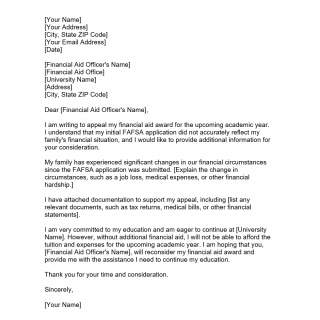FAFSA Appeal Letter
The Free Application for Federal Student Aid (FAFSA) is a form that determines a student's eligibility for financial aid, including grants, loans, and work-study programs. However, even if you have completed the FAFSA, you may not receive the amount of financial aid that you need or expect. In such cases, you can appeal the FAFSA decision by submitting an FAFSA Appeal Letter. This comprehensive guide will provide you with all the information you need to know about the FAFSA Appeal Letter, including its purpose, important fields, cases in which it is compiled, parties involved, features to consider when compiling, advantages, problems that can arise when filling out the form, related forms and alternative forms, differences from analogues, and where and how the form is submitted and stored.
The FAFSA Appeal Letter is used to appeal a decision by the Free Application for Federal Student Aid (FAFSA) regarding financial aid eligibility. The purpose of the form is to provide additional information that was not included in the original FAFSA application, which could affect the amount of financial aid that a student receives.
The FAFSA Appeal Letter typically consists of four parts: the introduction, the explanation of circumstances, the supporting documentation, and the conclusion. The introduction should state the purpose of the letter and provide the student's name, student ID number, and the academic year for which the appeal is being made. The explanation of circumstances should provide a detailed explanation of the circumstances that are affecting the student's financial situation. The supporting documentation should include any relevant documents that support the student's appeal, such as medical bills, layoff notices, or tax returns. The conclusion should summarize the student's appeal and request a reconsideration of the financial aid decision.
The most important fields in the FAFSA Appeal Letter are the explanation of circumstances and the supporting documentation. These fields provide the necessary information and evidence to support the student's appeal.
The FAFSA Appeal Letter is compiled when a student's financial aid eligibility is denied or reduced. The parties involved are the student and the financial aid office at the school that the student is attending or planning to attend.
When compiling the FAFSA Appeal Letter, it is important to provide a detailed explanation of the circumstances that are affecting the student's financial situation. The letter should also include any relevant supporting documentation, such as medical bills or layoff notices. The student should also ensure that the letter is well-written and free of errors.
FAFSA Appeal Letter Sample:
[Financial Aid Officer's Name]
[Financial Aid Office]
[University Name]
[Address]
[City, State ZIP Code]Dear [Financial Aid Officer's Name],
I am writing to appeal my financial aid award for the upcoming academic year. I understand that my initial FAFSA application did not accurately reflect my family's financial situation, and I would like to provide additional information for your consideration.
My family has experienced significant changes in our financial circumstances since the FAFSA application was submitted. [Explain the change in circumstances, such as a job loss, medical expenses, or other financial hardship.]
I have attached documentation to support my appeal, including [list any relevant documents, such as tax returns, medical bills, or other financial statements].
I am very committed to my education and am eager to continue at [University Name]. However, without additional financial aid, I will not be able to afford the tuition and expenses for the upcoming academic year. I am hoping that you, [Financial Aid Officer's Name], will reconsider my financial aid award and provide me with the assistance I need to continue my education.
Thank you for your time and consideration.
Sincerely,
[Your Name]
The FAFSA Appeal Letter provides students with an opportunity to appeal their financial aid eligibility decision and potentially receive more financial aid. This can help students to pay for their education and achieve their academic goals.
One of the main problems that can arise when filling out the FAFSA Appeal Letter is not providing enough information or evidence to support the appeal. This can result in the appeal being denied or delayed.
Related forms to the FAFSA Appeal Letter include the FAFSA form itself and the Student Aid Report (SAR), which is generated after the FAFSA is completed. Alternative forms include scholarship applications and private student loan applications. The main difference between the FAFSA Appeal Letter and these other forms is that the FAFSA Appeal Letter is specifically used to appeal a decision regarding financial aid eligibility.
The FAFSA Appeal Letter should be submitted to the financial aid office at the school that the student is attending or planning to attend. The letter can be submitted in person, by mail, or by email, depending on the school's policies. The financial aid office will review the appeal and make a decision regarding the student's financial aid eligibility. The FAFSA Appeal Letter should be stored in a safe place for future reference.
The FAFSA Appeal Letter is an important form that can help students to appeal a decision regarding their financial aid eligibility. By understanding the purpose, important fields, cases in which it is compiled, parties involved, features to consider when compiling, advantages, problems that can arise when filling out the form, related forms and alternative forms, differences from analogues, and where and how the form is submitted and stored, students can increase their chances of success when appealing their financial aid decision.

